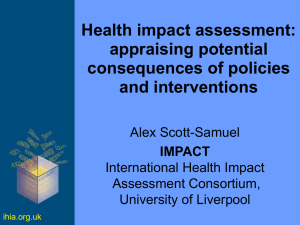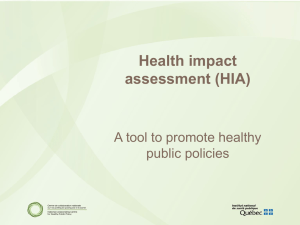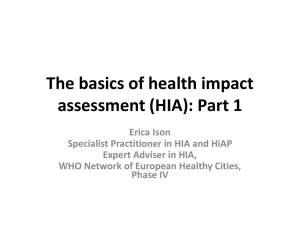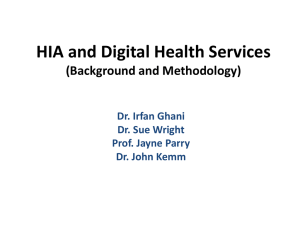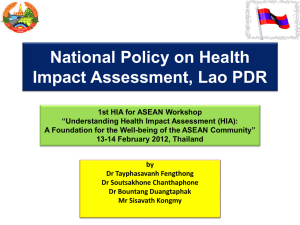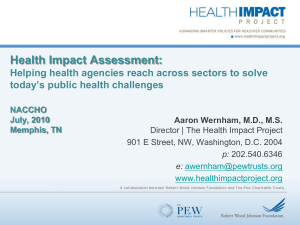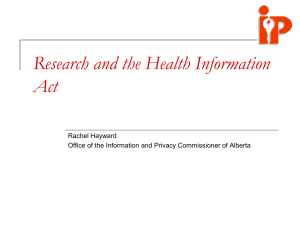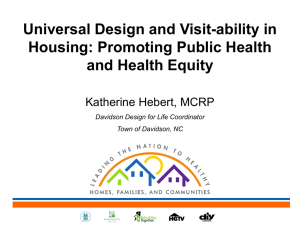Health Impact Assessments
advertisement
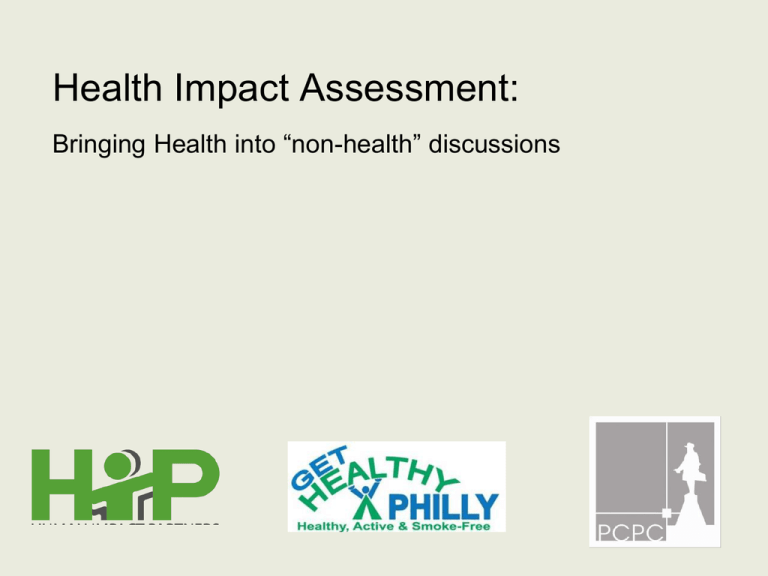
Health Impact Assessment: Bringing Health into “non-health” discussions 1 Why Health? Augmenting current decision-making processes Externalities Disparities Money is not the same as happiness A health frame can be persuasive People understand health personally Health is an indicator of quality of life and well-being Health is a shared value People are morally outraged by health inequities 2 HIA Definition Health Impact Assessment A combination of procedures, methods and tools that systematically judges the potential, and sometimes unintended, effects of a policy, plan, program or project on the health of a population and the distribution of those effects within the population. HIA identifies appropriate actions to manage those effects. International Association for Impact Assessment, 2006 3 HIA Addresses Determinants of Health How does the proposed project, plan, policy affect and lead to health outcomes 4 119 HIAs Completed or In Progress (2010) WA 8 ME 1 MT 3 MN 6 OR 12 NH 2 WI 1 MA 4 PA 2 OH 1 NJ 1 IL 1 CO 4 CA 47 MO 1 MD 2 KY 1 TN 1 NM 1 GA 8 TX 1 FL 1 AK 7 HI 1 Map Courtesy of A. Dannenberg, A. Wendel, CDC NCEH 5 Steps of HIA Screening Determines the need and value of a HIA Scoping Determines which health impacts to evaluate, methods for analysis, and a workplan Assessment Provides: 1) a profile of existing health conditions 2) evaluation of potential health impacts Recommendations Provide strategies to manage identified adverse health impacts Reporting Includes: 1) development of the HIA report 2) communication of findings & recommendations Monitoring Tracks: 1) impacts on decision-making processes and the decision 2) impacts of the decision on health determinants 6 When is a HIA carried out? The purpose of HIA is to inform decision-makers before they make decisions. A HIA is most often carried out prospectively before the decision is made or the policy is implemented. HIA is used to assess a defined project, plan or policy 7 Components of an HIA Scope Identify health determinants that proposal will impact Identify vulnerable populations Develop pathway diagrams Generate research questions Identify preliminary data sources and methods Determine goals Identify stakeholders and roles Create a workplan Develop a project timeline 8 Setting HIA Goals Common HIA Goals: Improve decision to account for health impacts Include health in the decision-making process Involve diverse stakeholders, including community members Build the capacity of stakeholders to use HIA Long Beach DTP HIA Increase capacity of community groups to use HIA Highlight the impacts of City Planning on Housing and Employment Demonstrate the value of HIA to stakeholders and agencies in Long Beach Ensure that environmental analysis considers mitigations for impacts to housing and employment Paid Sick Days HIA Conduct a policy-level HIA Highlight health evidence as part of the debate Draw public health practitioners into a new policy arena 9 Scoping Example: Housing Health Determinant: Housing Affordability Existing Conditions Research Question How affordable is the current housing stock for the existing population? Impact Research Question What will be the impact of the proposed plan on housing affordability? Indicators Proportion of renter and owner occupied housing Housing purchasing capacity Proportion of households paying greater than 30% of their incomes on housing Proportion of housing production to housing need by income category 10 The HIA Process Screening Scoping Assessment Recommendations Reporting Monitoring 11 Step 3: Assessment Objective To provide a profile of existing conditions data, and an evaluation of potential health impacts. Tasks Key points Tools Resources 12 HIA Assessment Steps Profile existing conditions Research baseline conditions, including health outcomes and determinants of health disaggregated by income, race, gender, age and place when possible. Can you use existing data or do you need to collect data? What methods will you use to collect data? Evaluate potential health impacts Use theory, baseline conditions, and population concerns; consider evidence that supports and refutes health impacts; assess affects by income, race, gender, age, and place; include assessments of the certainty, significance, and equity of impacts; justify the selection or exclusion of data/methods; identify data gaps, uncertainties, and limitations; allow stakeholders to critique findings What methods will you use to predict impacts? 13 HIA Data Collection Gather existing data and collect primary data when necessary empirical literature community expertise available social, economic, environmental, and health measures and surveys data regulatory criteria, standards, checklists and benchmarks focus groups and community surveys neighborhood assessment tools 14 Predicting Health Impacts Predicting impacts with absolute certainty is not possible. However, using the best available evidence, an HIA should present reasoned predictions of health impacts. It is not always necessary to quantify health impacts Use qualitative analysis for issues that don’t lend themselves to quantitative forecasting When possible, use tools and methods that already exist to assess health conditions and potential impacts 15 Air Quality Modeling Modeling vehicle source PM2.5 CAL3QHCR Line Source Dispersion Model A 1 g/m3 change in PM2.5 predicts a 1.4% change in non-injury mortality! Excelsior District, San Francisco Air Quality Model Inputs Traffic data Vehicle emissions rates Traffic speed Temperature and humidity Surface meteorology Number of receptors 16 Noise Modeling Noise Model Inputs Vehicle types and volumes The exposure threshold for increased incidence of heart disease is 65 dBA Temporal distribution of traffic Use traffic noise model to find exposure as function of distance Add topography and building sizes Add stationary sources 17 Pedestrian Injury Collision Modeling % Change in Pedestrian Injury 20% 21% 15% 24% Developing a Collision Model Traffic volume Arterial streets (% without transit) Land area Injury collision rates resulting from Eastern Neighborhoods Rezoning Percent car ownership Percent commuting via walking or transit Number of residents 18 Addressing HIA “Sticking Points” What do the critics say about HIA? What are some of the barriers and solutions to implementing a HIA practice? How do HIA and advocacy fit together? 19 What the Critics Say Criticism Response HIA is costly Not as costly as treatment of health impacts in the long run HIA is timeconsuming and will slow decisionmaking processes Conducting the HIA early will bring issues to the front of the decision-making process, potentially speeding approval processes and preventing costly litigation that delays projects HIA will stop economic development The role of HIA is to identify mitigations and recommendations, not to say “don’t do that” HIA is not scientific Role of HIA is to pull together disparate pieces of evidence to make a broad statement about impacts 20 EIA Extension to Health EIA Category Environmental Indicators Extension to Health Indicators Transportation Vehicle trips Vehicle volume Auto level of service Access to retail Traffic injuries Physical activity Noise exposure Air Quality Air quality standards Air pollution exposure Respiratory disease Housing Need to construct new housing Displacement Quality of housing Crowding/affordability Homelessness Social isolation Culture and Community Physical division of a community Loss of cultural and historical resources Social support Cultural practices Community violence 21 The HIA Process Screening Scoping Assessment Recommendations Reporting Monitoring 22 Step 4: Reporting Objective To develop the HIA report and communicate findings and recommendations. Tasks Key points Tools Resources 23 Step 5: Monitoring Objective To track the impacts of the HIA on the decisionmaking process and the decision, the implementation of the decision, and the impacts of the decision on health determinants. Tasks Key points Tools Resources 24 Developing an HIA Workplan Define the health determinants you are addressing Define the research questions for that health determinant State the goal for the HIA Identify partners and their roles in each HIA step Potential issues for the HIA scope Data needs Support needed to move forward Other resources for the HIA Project timeline Concrete next steps 25 N. American Practice Standards Minimum Elements Practice Standards http://www.humanimpact.org/component/jdownloads/finish/11/9 26 Health & Comprehensive Planning Lower South District HIA Scope • Evaluate potential health impacts of recommendations from Citywide Vision: 1) mixed-use TOD @ the Sports Complex 2) Completing subway extension to TNY • attempt to quantify impacts of alternative scenarios (no development, single-use development), (no transit, surface transit) • Focus on key health determinants: • Job access for vulnerable populations • Air quality, VMT, congestion, traffic safety • mixed-income housing & connection to transit, goods & services, parks, etc. • walkability & pedestrian activity Lower South District HIA Goals • Inform future land use plan and rezoning • Provide City Council members and their constituents with health-based rationales for adopting a revised zoning map • Bring new evidence in support of the subway extension, move the process along • Introduce HIA to Philadelphia Lower South District HIA Methods • Survey TNY employees/employers re: mode choice, commute times, housing location preferences, inclination and ability to shift modes in future (PIDC is partner) • Model future zoning scenarios, estimate impact on health-related issues • Estimate future population, quantify benefits (access, location efficiency, etc) • traffic counts @ TNY, FDR; work with Parks and Rec on survey of current users, levels of service, etc. HIA & Goods Movement: Considerations • Some case studies to learn from • Ports of LA & Long Beach • Oakland • Screening: what decision or future action might we actually influence? • Scoping: What research questions (and answers) most compelling to decisionmakers?

